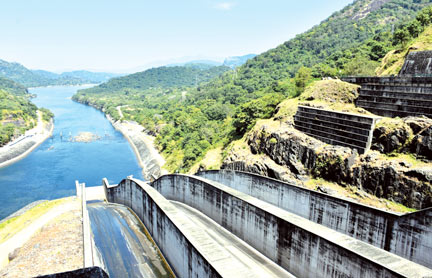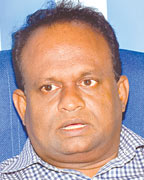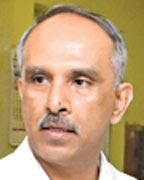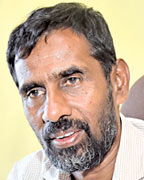Below the critical line
Dangerously low water levels in reservoirs has given
rise to a water war of sorts with the authorities facing the dilemma of
prioritising the use of this precious resource:
by Rukshana Rizwie
 Paying homage with a gilded pot of water to the Sri Maha Bodhi in
Anuradhapura, may not be much of an energy policy, yet this is what
officials were doing last week - praying for rain - which according to
folklore, parched and cracked lands would be blessed with rain and an
impending energy and water crisis will be alleviated. Senior Engineer
and Director of Major Dams at the Mahaweli Authority, S.R.K Aruppola, is
looking forward to a different gathering, a crucial panel meeting of the
Water Management Secretariat (WMS) in Gannoruwa on March 31. Paying homage with a gilded pot of water to the Sri Maha Bodhi in
Anuradhapura, may not be much of an energy policy, yet this is what
officials were doing last week - praying for rain - which according to
folklore, parched and cracked lands would be blessed with rain and an
impending energy and water crisis will be alleviated. Senior Engineer
and Director of Major Dams at the Mahaweli Authority, S.R.K Aruppola, is
looking forward to a different gathering, a crucial panel meeting of the
Water Management Secretariat (WMS) in Gannoruwa on March 31.
"The WMS meets bi-annually to discuss and negotiate water allocation,
but now we hold operational meetings weekly," he said. "The situation is
bleak. Typically, the reservoirs fill during this first inter-monsoonal
peak season which should have begun but it seems to have delayed."
Irrigation purposes
Water levels in the reservoirs have dropped and levels at the
Victoria reservoir was at 50% last week, Randenigala reservoir was at an
average of 97% and the Kotmale reservoir had reduced to a dismal 25%.
Water levels at the Rantambe rservoir had dropped. All charts read
'low.' If dry spells prevail, a power and water crisis is certain and
discussions on these lines are high on the agenda when the WMS meets.
 |
 |
 |
| Engr. Wasantha
Ehelapitiya |
Engr.
D.M.R.K.B Gunaratne |
Engr. E.M.S Bandara |
"We're prioritising water supply for irrigation purposes as opposed
to power generation," Aruppola said. "Power generation has alternatives,
but if the rivers reduce to a trickle, we won't have sufficient water
for drinking and the next harvest is sure to suffer."
He added that the Secretary to the Ministry of Mahaweli Development
and Environment, Udaya Seneviratne and the Director General of the
Mahaweli Authority Anura Dissanayake were closely monitoring the
situation.
When the WMS met last week, it was decided that water would be used
sparingly and only the minimum requirement for the day would be
disbursed for power generation.
Water released from Victoria has been minimised, while Moussakele and
Castlereagh cater to the Ceylon Electricity Board's daily requirement.
Bowatenna and Rantembe are restricted to feeding water to power only 11
megawatts and 25 megawatts for two peak hours during the day.
Engineer-in-charge of the Victoria Dam, E.M.S Bandara, said trading
water for power has been a gamble of late. "Spill levels of the Victoria
Dam should be 438m but we are now down to 421 m, which is 17m short," he
said. "It's not bad, but it's not plentiful either," he said.
At present, the dam releases water to power three megawatts of
electricity as stipulated by the CEB. "The reservoir needs to
continuously feed drinking water to the Horagama pump station." Bandara
is concerned that if the use of water is accelerated for power
generation, reservoirs will be reduced to shallow rivers.
Imbalances
The Victoria Dam was being renovated for corrosion. "The 122-m arch
dam generates 210 Megawatts of power to the parched national energy
grid," Udith Ekanayake, the civil engineer overseeing renovation work
said. "The last time huge jets of water were released from the sluice
gates were in January last year," he said.
"When water levels drop, energy stored also drops," D.M.R.K.B
Gunaratne, chief engineer of the Victoria Power Station said. "We are
saving energy by not releasing it for power or irrigation," he said.
All three turbines at the Victoria Power Station were in full swing
this past week. Each turbine generates 210 megawatts of electricity to
the national grid. "Even during the island-wide power outages, the
Victoria power station was generating energy." Gunaratne added that from
a technical perspective, it was easy to understand the power failures as
being due to imbalances.
"If the power imbalance is not controlled within a matter of seconds,
the power plant does load shedding, which is the plant's way of avoiding
excessive load," he said.
"The downfall is, that power can begin to cascade, leading to a
glitch and total failure."
As opposed to the Victoria Dam, the Randenigala reservoir which is
one of the largest reservoirs in Sri Lanka has reached spill level at
232 mean sea level (msl), but water levels at Rantambe has fallen to 152
msl.
Wasantha Ehelapitiya, engineer- in-charge at Randenigala and Rantambe
is confident that since water is hardly released from the Randenigala
reservoir for irrigation, it can be retained at this level.
"We're keeping a close watch on Randenigala to make sure the water
supply is not depleted, that is all we have," he said.
|

